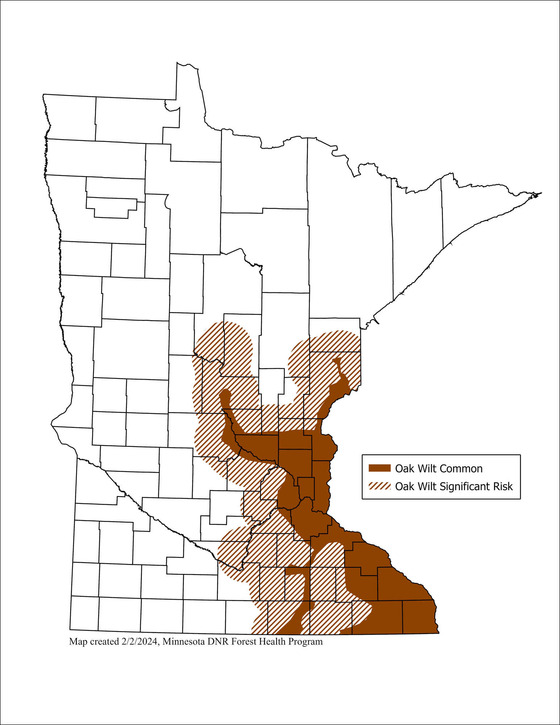In This Issue
The unusually warm winter might leave more than a mark on the record books ? it could hasten invasive oak wilt infection risk. Now is the safest time to prune and trim oak trees to prevent the spread of this deadly disease, according to the Minnesota Department of Natural Resources.
Oak wilt, a non-native fungal disease, is spread when sap-feeding beetles become active in warm weather and carry oak wilt spores from one tree to the next. These beetles are attracted to the sap from fresh wounds, such as those made by pruning. Once beetles introduce the fungus, it frequently spreads to neighboring oaks underground through connected roots.
?Don?t wait until after February to trim oak trees ? it might be too late,? said Brian Schwingle, DNR forest health coordinator. ?Oak wilt is widespread in parts of southeastern Minnesota, and pockets of disease extend to north and west of Brainerd. We can slow this northern progression by pruning oaks now, when the risk of oak wilt transmission is zero.?
Typically, April through July is the period of highest risk for oak wilt to spread. However, this winter is anything but typical. If late February and early March bring high temperatures approaching 60 F for a few consecutive days, sap-feeding beetles will become active much earlier than usual and oak wilt risk will increase. The last time that happened was in 2012.
If people must prune or cut oaks during a riskier period, they can greatly reduce infection risk by immediately applying a pruning paint to the fresh cut or stump. Always check the status of oak wilt risk at the University of Minnesota?s oak wilt in Minnesota website (extension.umn.edu/plant-diseases/oak-wilt-minnesota) before working on oak trees.?
DNR also cautions homeowners, campers, cabin owners, visitors, and hunters against moving oak firewood, which can spread oak wilt over long distances. Instead, use firewood sourced onsite or certified by the Minnesota Department of Agriculture?(mda.state.mn.us/plants/pestmanagement/firewood/firewooddealers) to prevent transporting oak wilt and other invasive species.
For more details on oak wilt, including identification, prevention and how best to deal with infected trees and wood, visit the?DNR?s oak wilt management webpage (mndnr.gov/treecare/forest_health/oakwilt/management.html).
 Oak wilt's known range in Minnesota. Photo credit: Minnesota Department of Natural Resources
###
As part of its effort to update the Carlos Avery Wildlife Management Area master plan, the Minnesota Department of Natural Resources is asking for input from people interested in the WMA.
The 24,600-acre WMA consists of wetlands, forest, grasslands, and small lakes that provide extensive hunting, trapping, wildlife watching, and other outdoor recreation opportunities just 30 miles north of the Twin Cities.
The WMA master plan was last revised in 1977 and it is important for this update to address environmental changes, advances in scientific knowledge, and changes in public values and use. The plan will include management goals, objectives and strategies for the WMA for the next 10 years.
Public input opportunities
The Minnesota DNR is specifically looking for input that will help determine the content of the plan. Input received will be used to help develop a draft plan that will be available for public review this fall.
There are several opportunities to engage in the planning process:
First, an online questionnaire is available on the DNR website (mndnr.gov/areas/wildlife/carlos_avery_wma.html) through Friday, March 15. This questionnaire will allow people to provide thorough input concerning their use of, and preferences for, the WMA.
Second, the DNR will host two public meetings, one in person and one online. The DNR staff will present a brief overview of the WMA and the planning process, answer questions and take feedback.
- In-person public meeting: 6-8 p.m. Wednesday, Feb. 28, at the Carlos Avery WMA Office Conference Room, 5463-C West Broadway Ave., Columbus, MN 55025.
- Online public meeting: 6-8 p.m. Wednesday, March 6. Registration is not required, and more information is available on the Minnesota DNR website (mndnr.gov/areas/wildlife/carlos_avery_wma.html).
Finally, written comments on the master plan can also be submitted by emailing [email protected] or sending mail to Carlos Avery WMA, 5463-C West Broadway, Forest Lake, MN 55025.
About the WMA
Carlos Avery WMA?s wetlands and shallow lakes, forests, savanna, and prairie uplands are home to many game and nongame species and are popular with hunters, trappers, and bird and wildlife watchers. There is also a 4,500-acre wildlife sanctuary within the WMA. The WMA is about two-thirds wetland, including 26 pools actively managed to provide waterfowl habitat and waterfowl hunting opportunities. The WMA also has 45 miles of rivers and streams.
More information about the WMA is available on the Minnesota DNR website (mndnr.gov/areas/wildlife/carlos_avery_wma.html).
###
|
